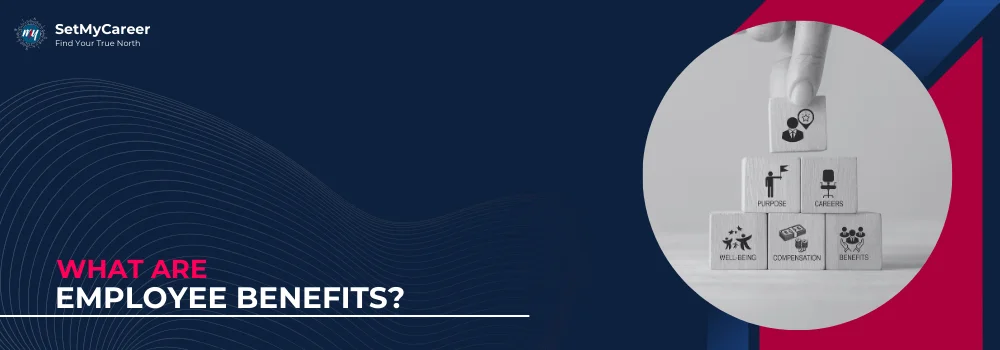
Published by Dr. Nandkishore Rathi on 19 March 2025
Chief Career Navigator
Dr. Nandkishore Rathi is passionate about identifying people's passions and helping them create and lead successful and fulfilling careers. With 30+ years of experience and interactions with thousands of students, academicians, and corporate executives, he has developed a range of career services aimed at benefiting individuals seeking a breakthrough in their professional lives.
A complete guide to employee benefits—why they matter, legal rights in India, and how to maximize perks for a better work-life balance.

Imagine this: Two companies offer you the same salary. One provides just the paycheck, while the other offers health insurance, flexible work schedules, paid vacations, a gym membership, and tuition reimbursement. Which job would you take? If you’re like most people, you’d go for the one that values your well-being beyond your work hours.
In today’s fast-paced world, employee benefits are no longer "nice-to-haves"—they're essential. They shape how employees feel about their jobs, influence productivity, and determine whether a company attracts top talent or loses them to competitors. Let’s dive into the world of employee benefits, understand their impact, and explore how they shape both employees’ lives and career success.
Think of employee benefits as the “extra perks” that make a job more than just a paycheck. They enhance well-being, provide financial security, and help employees balance work and life.
But here’s the catch—not all benefits are created equal. Some are legally required, while others set companies apart as top-tier employers.
Mandatory Benefits: These are required by law, such as social security, healthcare, and unemployment insurance.
Voluntary Benefits: These include perks like remote work, wellness programs, and tuition assistance—designed to keep employees engaged and happy.
Employers who invest in strong benefits are not just looking for employable skills and promising talent—they are thinking more long-term— to build a loyal, motivated workforce
A great benefits package is more than a checklist—it’s a strategic advantage.
For Employees:
Better Health & Financial Security – Reduced stress and peace of mind.
Work-Life Balance – Increased productivity and happiness.
Career Growth – Continuous learning opportunities.
For Employers:
Higher Retention – Happy employees stay longer.
Increased Productivity – Healthy, well-rested employees work better.
Stronger Employer Brand – A competitive benefits package makes hiring easier.
In short, benefits drive success on both sides.

Unlock the full potential of your job benefits.
Maximize BenefitsEmployee benefits in India are governed by labor laws to ensure fair treatment and workplace security.
Health & Insurance: Employers with 10+ employees must provide ESI for workers earning up to ₹21,000/month. Compensation for job-related injuries is mandated under the Workmen’s Compensation Act.
Retirement & Pension: EPF contributions are mandatory, and employees with 5+ years of service are entitled to gratuity.
Paid Leave: 26 weeks of paid maternity leave under the Maternity Benefit Act. Other leave policies vary by state.
Wages & Overtime: Minimum wages depend on industry and region. Overtime beyond 48 hours/week must be paid at double the rate.
Equal Benefits: Laws prevent gender-based pay gaps and ensure equal opportunities for persons with disabilities
Knowing these rights helps employees secure fair treatment at work.
Let’s break it down: What do employees actually want?
Health & Wellness Benefits (Because Health is Wealth)
Comprehensive Health Insurance – Covers doctor visits, surgeries, and mental health support.
Dental & Vision Plans – Because nobody wants to pay out-of-pocket for a root canal!
Mental Health Support – Therapy sessions, Employee Assistance Programs (EAPs), and stress management.
Gym Memberships & Wellness Programs – Healthy employees are productive employees.
Financial Benefits (More Than Just a Paycheck)
Retirement Plans (401(k), Pension Funds, etc.) – Financial security for the future.
Stock Options & Profit Sharing – Employees share in company success.
Tuition Reimbursement & Student Loan Assistance – Keep learning without financial stress.
Financial Planning Services – Budgeting, investments, and wealth management.
Work-Life Balance (The Secret to Long-Term Happiness at Work)
Remote Work & Flexible Schedules – Because 9-to-5 isn’t for everyone.
Generous Paid Time Off (PTO) – Vacation, personal days, and mental health breaks.
Parental Leave & Childcare Assistance – Family-friendly workplaces retain top talent.
Sabbaticals – Extended time off to recharge, travel, or explore new skills.
Career Growth & Development (Investing in the Future)
Tuition Reimbursement – Helps employees continue education while working.
Leadership Training & Career Coaching – Helps employees climb the career ladder.
Conferences & Industry Workshops – Networking and learning opportunities.
Unique & Emerging Perks (Because Modern Workplaces Are Evolving)
Pet Insurance – Because pets are family, too!
Commuter Benefits – Public transport subsidies, fuel allowances, or company shuttles.
Free Meals & Snacks – Keeping employees well-fed leads to happier teams.
Corporate Discounts & Memberships – Special deals on entertainment, shopping, and travel.
The best companies mix traditional benefits with modern perks, creating a workplace people genuinely love.
Investing in a structured course can significantly boost your chances of success.
As an employee, understanding and maximizing your benefits is key to long-term success. Here’s how:
Read the Fine Print – Know what benefits your company offers and how to use them.
Take Advantage of Health & Wellness Programs – Preventative care and mental health support can save you stress (and money) in the long run.
Plan for the Future – Utilize retirement plans, stock options, and financial planning resources.
Balance Work & Life – Make use of vacation days and flexible work options to avoid burnout.
Ask Questions – HR is there to help. Don’t hesitate to clarify any doubts about your benefits.
The modern workplace is changing, and so are employee expectations. Companies that prioritize well-being, work-life balance, and career development will outperform competitors in hiring and retention.
So when you’re negotiating job offers, apart from looking out for the highest paying jobs, also negotiate for better benefits, simply making the most of what’s available to you. Understanding employee benefits is crucial for navigating a smooth career path. Want to ensure you're getting the best out of your job? Start by knowing your benefits inside out.
No. 14/595, 1st Floor, Nanjappa Reddy Layout, Koramangala 8th Block, Bangalore 560095